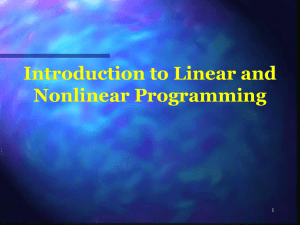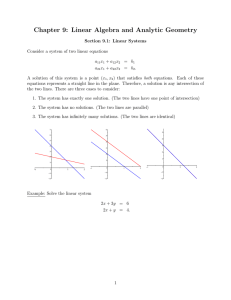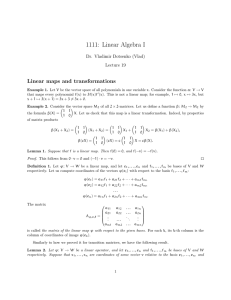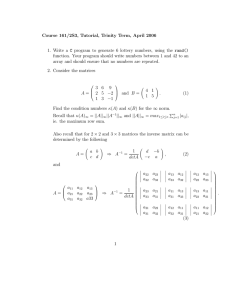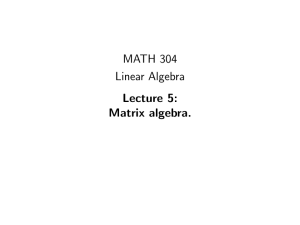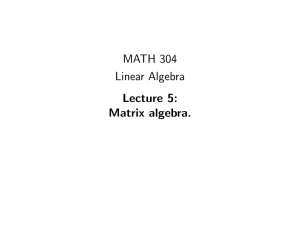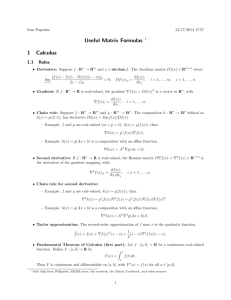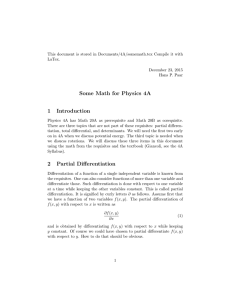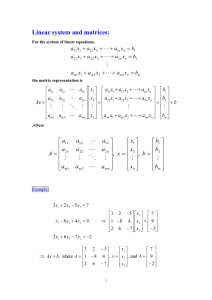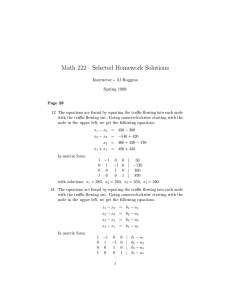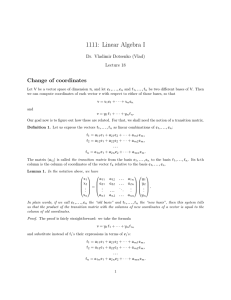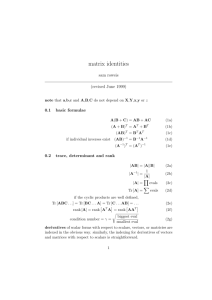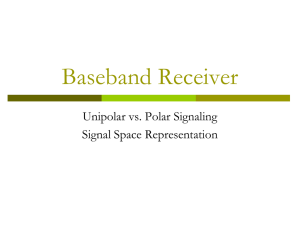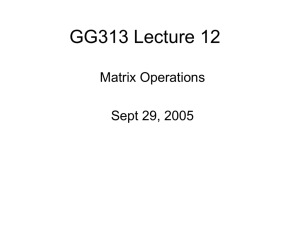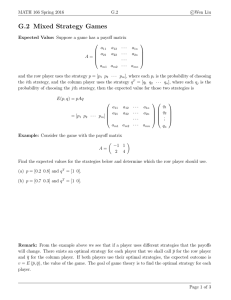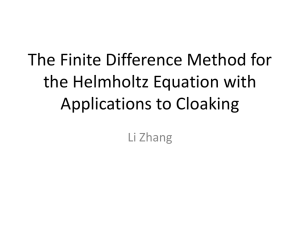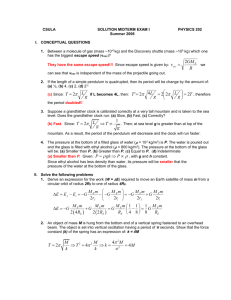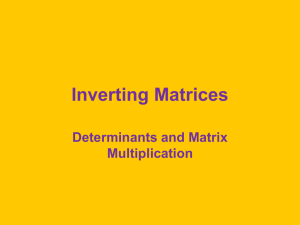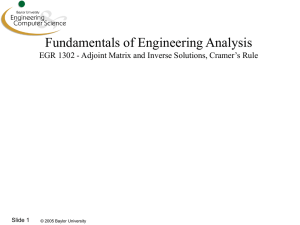CHAPTER 2
advertisement
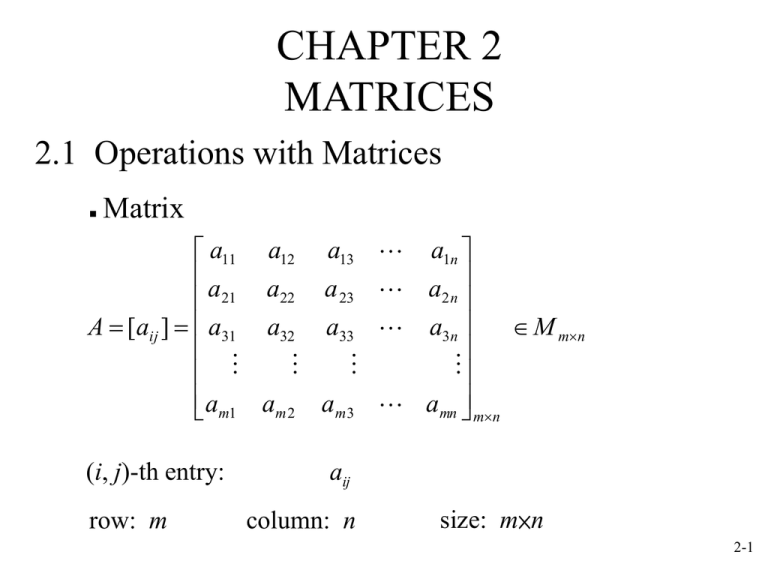
CHAPTER 2 MATRICES 2.1 Operations with Matrices Matrix a11 a12 a13 a1n a a a a 22 23 2n 21 A [aij ] a31 a32 a33 a3n M mn am1 am 2 am 3 amn mn (i, j)-th entry: row: m aij column: n size: m×n 2-1 i-th row vector ri ai1 ai 2 ain j-th column vector c1 j c 2j cj c mj row matrix column matrix Square matrix: m = n 2-2 2-3 2-4 2-5 2-6 Matrix form of a system of linear equations: a11 x1 a12 x2 a1n xn b1 a x a x a x b 21 1 22 2 2n n 2 am1 x1 am 2 x2 amn xn bm m linear equations a11 a 21 am1 a12 a22 am 2 a1n x1 b1 a2 n x2 b2 amn xn bm = = = A x b Single matrix equation Ax b m n n 1 m 1 2-7 Partitioned matrices: submatrix a11 A a21 a31 a12 a13 a22 a32 a23 a33 a11 A a21 a31 a14 A11 a24 A21 a34 a12 a13 a22 a32 a23 a33 a11 A12 a A 21 A22 a31 a14 a24 c1 c2 a34 c3 a12 a13 a22 a32 a23 a33 a14 r1 a24 r2 a34 r3 c4 2-8 a linear combination of the column vectors of matrix A: a11 a A 21 am1 a12 a22 am 2 x1 x x 2 xn a1n a2 n c1 c2 cn amn a11 x1 a12 x2 a1n xn a11 a21 a1n a x a x a x a a a 2n n Ax 21 1 22 2 x1 21 x2 22 xn 2 n a x a x a x a a mn n m1 m1 1 m 2 2 m1 m2 amn = c2 = = x1c1 x2c2 xncn c1 cn linear combination of column vectors of A 2-9 2.2 Properties of Matrix Operations Three basic matrix operators: (1) matrix addition (2) scalar multiplication (3) matrix multiplication Zero matrix: 0mn Identity matrix of order n: I n 1 0 0 0 1 0 0 0 1 2-10 2-11 2-12 2-13 Real number: ab = ba (Commutative law for multiplication) Matrix: AB BA mn n p Three situations: (1) If m p , then AB is defined,BA is undefined. (2) If m p, m n, then AB M mm,BA M nn (Sizes are not the same) (3) If m p n, then AB M mm,BA M mm (Sizes are the same, but matrices are not equal) 2-14 Real number: ac bc , c 0 (Cancellation law) ab Matrix: AC BC C0 (1) If C is invertible, then A = B (2) If C is not invertible, then A B (Cancellation is not valid) 2-15 2-16 Transpose of a matrix: a11 a If A 21 a m1 a12 a22 am 2 a11 a Then AT 12 a 1n a1n a2 n M mn amn a21 am1 a22 am 2 M nm a2 n amn 2-17 2-18 2-19 Symmetric matrix: A square matrix A is symmetric if A = AT Skew-symmetric matrix: A square matrix A is skew-symmetric if AT = –A T Note: AA is symmetric Proof: ( AA ) ( A ) A AA T T T T T T AAT is symmetric 2-20 2.3 The Inverse of a Matrix Notes: AA 1 A1 A I 2-21 A -Jordan Elimination | I Gauss I | A1 If A can’t be row reduced to I, then A is singular. 2-22 Power of a square matrix: (1) A0 I (2) Ak AA A (k 0) k factors (3) Ar As Ar s d1 0 (4) D 0 r, s : integers 0 d1k 0 0 Dk d n 0 0 d2 0 ( Ar ) s Ars 0 d 2k 0 0 0 k dn 2-23 2-24 Note: A1 A2 A3 An 1 An1 A31 A21 A11 2-25 Note: If C is not invertible, then cancellation is not valid. 2-26 2-27 2.4 Elementary Matrices Note: Only do a single elementary row operation. 2-28 2-29 2-30 2-31 Note: If A is invertible Then Ek E3 E2 E1 A I A1 Ek E3 E2 E1 A E11E21E31 Ek1 Ek E3 E2 E1[ A I ] [ I A1 ] 2-32 2-33 2-34 Note: If a square matrix A can be row reduced to an upper triangular matrix U using only the row operation of adding a multiple of one row to another, then it is easy to find an LU-factorization of A. Ek E2 E1 A U A E11 E21 Ek1U A LU 2-35 Solving Ax=b with an LU-factorization of A Ax b If A LU, then LUx b Let y Ux, then Ly b Two steps: (1) Write y = Ux and solve Ly = b for y (2) Solve Ux = y for x 2-36


